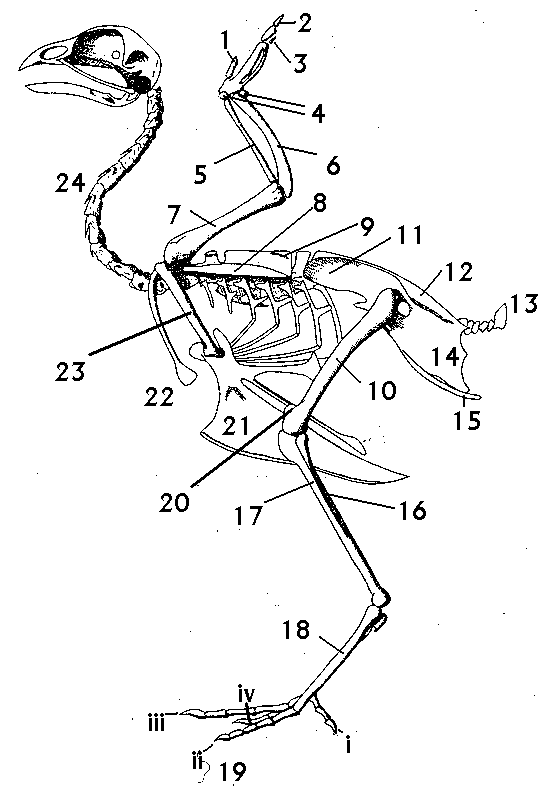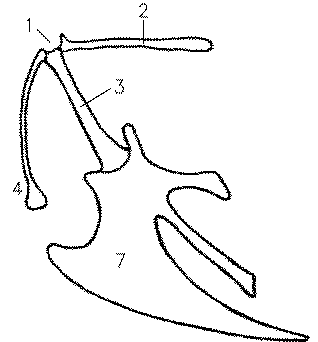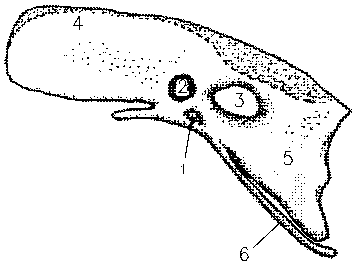LAB 10.1 Poultry skeleton
PLAY VIDEO

1. Wing digit 1
2. Wing digit 2
3. Wing digit 3
4. Carpals
5. Radius
6. Ulna
7. Humerus
8. Scapula
9. Thoracic vertebrae
10. Femur
11. Ilium
12. Synsacrum
13. Pygostyle
14. Ischium
15. Pubis
16. Fibula
17. Tibiotarsus
18. Tarsometatarsus
19. Four foot digits
20. Patella
21. Carina of sternum
22. Furcula of 2 clavicles
23. Coracoid
24. Cervical vertebrae
Vertebrae
- highly fused
Cervical, n = 14 free
Thoracic, n = 7
T2 to T5 are fused
T6 free
T7 fused to synsacrum (T7 + LS1 to LS14 + C1)
Lumbosacral, n = 14 fused
Caudal, n = 6
The synsacrum = T7 + LS1 to LS14 + C1
The skeletons of poultry are radically
different from those of the farm mammals. Not only is the avian
skeleton
adapted for flight, but birds and mammals are only distantly related
zoologically.
Skull and neck. The skull has
very large eye orbits and a small cranial cavity.
The long double curved neck contains 14 cervical vertebrae, and the
ring‑like
atlas articulates to the skull with only a single occipital condyle.
The axis
has a large odontoid process that projects anteriorly.
Vertebral column. There are 7
thoracic
vertebrae, but numbers 2 to 5 are fused. Thoracic vertebrae 6 can move
freely,
but the last thoracic vertebra is fused to the synsacrum. The synsacrum
is a
fused length of the vertebral column that contains thoracic vertebra 7,
14
lumbo-sacral vertebrae, and the first coccygeal or caudal vertebra, but
skeletal fusion in the vertebral column does not occur for many weeks
after
hatching. There are six caudal vertebrae that, apart from
the
first, are free and mobile. However, only numbers 2 to 5 are normal
vertebrae,
since the last one is formed into a three sided pyramidal bone called
the
pygostyle.
Ribs. There
are seven ribs: the first two are
free while the last five are attached to the sternum. There are no
costal
cartilages. Ribs 2 to 6 each have an uncinate process which overlaps
the next
posterior rib. The sternum is extremely large.
It has a conspicuous ventral ridge in the midline, the CARINA,
which
increases the area available for attachment of the flight muscles. The
dorsal
surface of the expanded sternum is concave and forms the floor of a
continuous
thoracic and abdominal cavity.

Glenoid (1), scapula (2), coracoid (3), clavicle (4) and sternum
(7).
Wing. The
bones of the fore limb are greatly
modified to form the wing (Figure 2‑19). Distal to the humerus are the
widely
spaced radius and ulna. The carpals, metacarpals and digits are reduced
to form
a stiff skeletal unit for the anchorage of the primary flight feathers.
The
three digits of the wing are equivalent to digits 2, 3, and 4 in other
animals . The wing articulates with the body at the glenoid cavity
which is strengthed by the convergence of three bones, the scapula, the
coracoid and the clavicle. In birds the coracoid is a separate bone,
whereas in
mammals it has been reduced to a small integral part of the scapula.
The
clavicles of right and left sides are fused ventrally to form the
furcula or
wishbone. Although many mammals have a pair of clavicles, they are
absent in
cattle, sheep and pigs. The clavicle functions as a strut to support
the shoulder
joint in animals which have complete mobility of the shoulder joint.
Since
cattle, sheep and pigs have cursorial limbs with a restricted fore and
aft
movement, they do not need clavicles. In poultry, the distal end of the
coracoid is braced against the sternum. In flight, the body of a
bird hangs from its wings at the shoulder joint, hence the more
elaborate
support for the glenoid cavity.

Digits 1, 2 and 3; carpometacarpus (4), radius (5), ulna (6) and
humerus (7).
Leg. In
poultry, the legs show many cursorial
adaptations. Distal to the femur, the fibula is reduced to leave the
tibia as
the major bone. In the embryo this occurs as a result of the
differential growth and translocation of the distal part of the fibula
to
become part of the tibia. The proximal tarsal bones are
fused to the distal end of the tibia to increase its length, and the
whole
skeletal unit may be called the tibiotarsus. The distal tarsal bones
are
incorporated into the proximal end of a single bone, the
tarsometatarsus, which
also includes the fused metatarsals 2, 3 and 4. Of the four digits
which form
the bird's claw, digit 1 is directed posteriorly while digits 2, 3 and
4 are
anterior. This adpatation enables the bird to perch. The ilium is fused
to the
synsacrum. Instead of being fused in the midline, the pubic bones are
separate,
and they project backwards as thin rods. The open structure of
the pelvis in the ventral region facilitates the passage of eggs from
the body
cavity. The ilium, ischium and pubis all contribute to the acetabulum,
but the
ilium forms more than half of the socket and the floor is membranous .

Digits 1, 2 3 and 4; tarsometatarsus (5), tibiotarsus (6), fibula (7)
and femur (8).

Obturator foramen (1), acetabulum (2), sciatic foramen (3), ilium (4),
ischium (5) and pubis (6).





